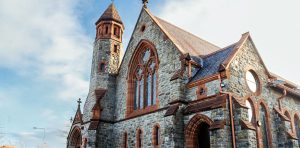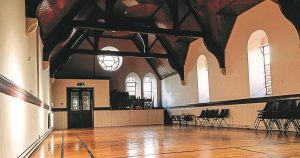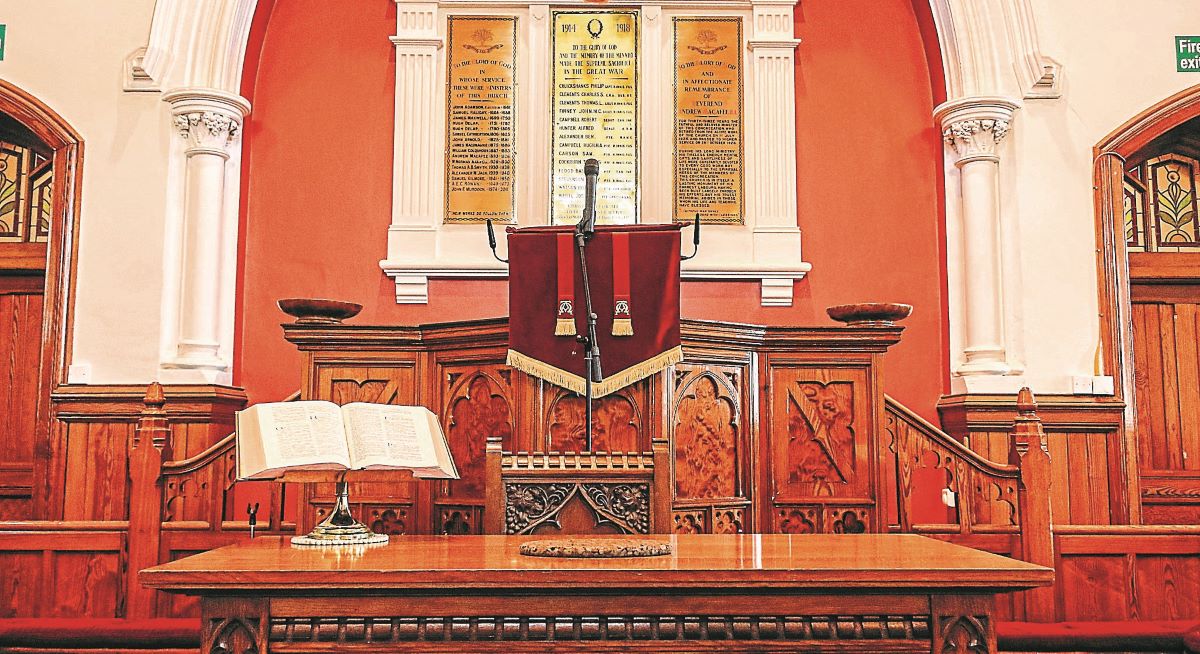Origins of First Presbyterian Church date back to 1600s
Directly opposite Omagh Library stands a tall, gorgeous red and grey brick church, which looms over the Dublin Road.
Many of us will walk and drive past it daily, but few know that this building hosts one of the longest-established congregations in Omagh’s history.



The congregation of First Omagh Presbyterian Church has survived through thick and thin for 350 years, since it was first formed in 1673.
Initially, they worshipped at Crevenagh before moving to a site on the Dublin Road, where Logan & Corry Solicitors is presently located.
In 1864, a fire destroyed the minister’s house and important historical records kept within it.
The congregation then decided to build a new church on the Dublin Road, and in 1897, the first service was held in the building we can see today.
I was fortunate to be given a tour of this historic church by the current minister, Jane Nelson.
Arriving on a crisp morning dressed in my best Sunday outfit (on a Friday), my glasses fogged up as I entered the hall.
But, after a quick wipe, I became mesmerised by its simple yet breathtaking design, lined with stained glass depictions of Jesus and Mary, which I found out, were owned by families of the congregation.
Minister Nelson and I roamed the isles as we conversed over the growing secularisation of society and the relevance of church life in the world of young people.
We took a trip up the spiral staircase from where I looked down over the pews.
I circled the choir benches and felt the energy of the angelic voices which echo through this house of Christianity when full of people.
Whilst surrounded by relics of history in the fading woodworks and plaster, I also observed the more recent legacy of Covid-19.
Cameras and mixing desks sat in the front and centre of the choir pews, providing an online service for the convenience of those who wish to remain at home.
The origins of the the congregation date back to 1673, when a decision by the Laggan Presbytry declared that, ‘A meeting-house must be built in Omey’ (An old term for Omagh).
With that call-to-action, construction began near Crevenagh three years afterwards, and, by 1677, Rev Samuel Haliday was instated as one of the first ministers in the area.
However, Rev Haliday’s ministry was cut short as the revolution against King James in 1688 saw him flee to his native Scotland. He returned four years later to reside in Ardstraw, but he would never return to the Presbytry in Omagh. This left the newly-founded congregation leaderless and unable to support itself.
The vacancy was then filled ten years later by a James Maxwell, who served the church until his death in 1750. It was during Maxwell’s ministry in 1721 that the church moved to its first site on the Dublin Road, where Logan & Corry’s office is today.
The only remnants of that church’s existence on this site is a blue plaque and cobble walls dating back to that era.
Following the death of Mr Maxwell, the third minister in the congregation’s history, Hugh Delap, was ordained.
However, this caused conflict within the congregation,, and resulted in an exodus of approximately 50 families who sought to develop their own presbytery. Mr Delap then passed away in 1797, and was succeeded by his son in 1790. Controversy struck again, as this minister would only survive 15 years before his dismissal for ‘immoral behaviour’.
The fifth minister, Samuel Cuthbertson, was be ordained on June 11, 1806, and he sought to develop the church with a change from thatched to slated roof, a full repair programme and the addition of pews.
Despite this refurbishment, Mr Cuthbertson also faced more controversy due to ‘inefficiency in running the church’ resulting from his problem with drinking!
By this stage, much of the congregation had left to join other churches because of the mismanagement which forced a recommendation that Mr Cuthbertson should retire from his ministry.
The newly-refurbished church on the Dublin Road was officially reopened in September 1862, under the ministry of John Arnold, but the pattern of short, tragic ministries kept to its routine, and Mr Arnold would step down seven years later due to ill health.
The current church was then built on its new site following years of back-and-fourth disagreements over where and what size it should be built, with suggestions such as moving to Castlederg being fought over by the congregation.
However, after years of fundraising, the new building was eventually finished, and the first official service was held on May 30, 1897.
Since that new beginning under the ministry of Reverand Andrew Macafee, the church has remained mostly conflict-free.
The building remained largely the same for nearly 100 years, until 1977, when the Rowan Hall was built as an extension to accommodate the rising numbers of Sunday school children.
Today, the church still welcomes dozens of families through its doors, just as their predecessors did nearly 300 years ago in ‘The Omey’, following the same Christian beliefs and values.







